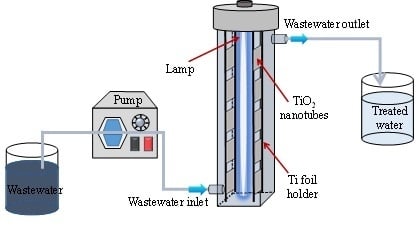Continuous-Flow Photocatalytic Degradation of Organics Using Modified TiO2 Nanocomposites
Abstract
:1. Introduction
2. Results and Discussion
2.1. Characterization Results
2.1.1. Field Emission Scanning Electron Microscopy
2.1.2. X-ray Diffraction
2.1.3. Energy Dispersive X-ray Spectroscopy
2.1.4. Auger Electron Spectroscopy
2.1.5. Photoluminescence Spectroscopy
2.1.6. X-ray Photoelectron Spectroscopy
2.2. Photocatalytic Degradation in Continuous-Flow Treatment
2.2.1. Photocatalytic Degradation under UV C Light
2.2.2. Photocatalytic Degradation under Visible Light
2.3. Reusability Test
2.4. Calculation of Quantum Efficiencies
3. Materials and Methods
3.1. Chemicals and Materials
3.2. Synthesis of the Catalysts
3.2.1. Synthesis of GO and RGO
3.2.2. Synthesis of GO-TNT
3.2.3. Synthesis of RGO-TNT
3.2.4. Synthesis of Bi-TNT
3.3. Characterization
3.4. Continuous-Flow Photocatalytic Experiment
4. Conclusions
Acknowledgments
Author Contributions
Conflicts of Interest
References
- Liu, Y.; Zhang, Y.; Wang, L.; Yang, G.; Shen, F.; Deng, S.; Zhang, X.; He, Y.; Hu, Y.; Chen, X. Fast and large-scale anodizing synthesis of pine-cone TiO2 for solar-driven photocatalysis. Catalysts 2017, 7, 229. [Google Scholar] [CrossRef]
- Meriam Suhaimy, S.H.; Abd Hamid, S.B.; Lai, C.W.; Hasan, M.R.; Johan, M.R. TiO2 nanotubes supported Cu nanoparticles for improving photocatalytic degradation of simazine under UV illumination. Catalysts 2016, 6, 167. [Google Scholar] [CrossRef]
- Kuang, D.; Brillet, J.; Chen, P.; Takata, M.; Uchida, S.; Miura, H.; Sumioka, K.; Zakeeruddin, S.M.; Grätzel, M. Application of highly ordered TiO2 nanotube arrays in flexible dye-sensitized solar cells. ACS Nano 2008, 2, 1113–1116. [Google Scholar] [CrossRef] [PubMed]
- Albu, S.P.; Ghicov, A.; Macak, J.M.; Hahn, R.; Schmuki, P. Self-organized, free-standing TiO2 nanotube membrane for flow-through photocatalytic applications. Nano Lett. 2007, 7, 1286–1289. [Google Scholar] [CrossRef] [PubMed]
- Paulose, M.; Varghese, O.K.; Mor, G.K.; Grimes, C.A.; Ong, K.G. Unprecedented ultra-high hydrogen gas sensitivity in undoped titania nanotubes. Nanotechnology 2005, 17, 398–402. [Google Scholar] [CrossRef]
- Liu, J.; Han, T.; Sun, B.; Kong, L.; Jin, Z.; Huang, X.; Liu, J.; Meng, F. Catalysis-based cataluminescent and conductometric gas sensors: Sensing nanomaterials, mechanism, applications and perspectives. Catalysts 2016, 6, 210. [Google Scholar] [CrossRef]
- Guayaquil-Sosa, J.; Calzada, A.; Serrano, B.; Escobedo, S.; de Lasa, H. Hydrogen production via water dissociation using Pt–TiO2 photocatalysts: An oxidation–reduction network. Catalysts 2017, 7, 324. [Google Scholar] [CrossRef]
- Fiorenza, R.; Bellardita, M.; D’Urso, L.; Compagnini, G.; Palmisano, L.; Scirè, S. Au/TiO2-CeO2 catalysts for photocatalytic water splitting and vocs oxidation reactions. Catalysts 2016, 6, 121. [Google Scholar] [CrossRef]
- Zheng, Q.; Zhou, B.; Bai, J.; Li, L.; Jin, Z.; Zhang, J.; Li, J.; Liu, Y.; Cai, W.; Zhu, X. Self-organized TiO2 nanotube array sensor for the determination of chemical oxygen demand. Adv. Mater. 2008, 20, 1044–1049. [Google Scholar] [CrossRef]
- Lin, L.; Wang, H.; Jiang, W.; Mkaouar, A.R.; Xu, P. Comparison study on photocatalytic oxidation of pharmaceuticals by TiO2-Fe and TiO2-reduced graphene oxide nanocomposites immobilized on optical fibers. J. Hazard. Mater. 2017, 333, 162–168. [Google Scholar] [CrossRef] [PubMed]
- Giovannetti, R.; Rommozzi, E.; Zannotti, M.; D’Amato, C.A. Recent advances in graphene based TiO2 nanocomposites (GTiO2Ns) for photocatalytic degradation of synthetic dyes. Catalysts 2017, 7, 305. [Google Scholar] [CrossRef]
- Zabihi, F.; Ahmadian-Yazdi, M.-R.; Eslamian, M. Photocatalytic graphene-TiO2 thin films fabricated by low-temperature ultrasonic vibration-assisted spin and spray coating in a sol-gel process. Catalysts 2017, 7, 136. [Google Scholar] [CrossRef]
- Wang, J.; Jing, L.; Xue, L.; Qu, Y.; Fu, H. Enhanced activity of bismuth-compounded TiO2 nanoparticles for photocatalytically degrading rhodamine B solution. J. Hazard. Mater. 2008, 160, 208–212. [Google Scholar] [CrossRef] [PubMed]
- Fischer, K.; Gawel, A.; Rosen, D.; Krause, M.; Abdul Latif, A.; Griebel, J.; Prager, A.; Schulze, A. Low-temperature synthesis of anatase/rutile/brookite TiO2 nanoparticles on a polymer membrane for photocatalysis. Catalysts 2017, 7, 209. [Google Scholar] [CrossRef]
- Cadevall, M.; Ros, J.; Merkoçi, A. Bismuth-based nanomaterials and platforms for sensing and biosensing applications. In Functional and Physical Properties of Polymer Nanocomposites; John Wiley & Sons: Chichester, UK, 2016; p. 159. [Google Scholar]
- Chai, S.Y.; Kim, Y.J.; Jung, M.H.; Chakraborty, A.K.; Jung, D.; Lee, W.I. Heterojunctioned biocl/Bi2O3, a new visible light photocatalyst. J. Catal. 2009, 262, 144–149. [Google Scholar] [CrossRef]
- Li, D.; Zhang, Y.; Zhang, Y.; Zhou, X.; Guo, S. Fabrication of bidirectionally doped β-Bi2O3/TiO2-NTs with enhanced photocatalysis under visible light irradiation. J. Hazard. Mater. 2013, 258, 42–49. [Google Scholar] [CrossRef] [PubMed]
- Geim, A.K.; Novoselov, K.S. The rise of graphene. Nat. Mater. 2007, 6, 183–191. [Google Scholar] [CrossRef] [PubMed]
- Xiang, Q.; Yu, J.; Jaroniec, M. Graphene-based semiconductor photocatalysts. Chem. Soc. Rev. 2012, 41, 782–796. [Google Scholar] [CrossRef] [PubMed]
- Li, L.; Zhou, Z.; Lei, J.; He, J.; Zhang, S.; Pan, F. Highly ordered anodic TiO2 nanotube arrays and their stabilities as photo (electro) catalysts. Appl. Surf. Sci. 2012, 258, 3647–3651. [Google Scholar] [CrossRef]
- Zhang, A.; Zhou, M.; Han, L.; Zhou, Q. Combined potential of three catalysis types on TiO2 nanotube (TNT)/Ti and nanoparticle (TNP)/Ti photoelectrodes: A comparative study. Appl. Catal. A Gen. 2010, 385, 114–122. [Google Scholar] [CrossRef]
- Wu, M.; Duan, T.; Chen, Y.; Wen, Q.; Wang, Y.; Xin, H. Surface modification of TiO2 nanotube arrays with metal copper particle for high efficient photocatalytic reduction of Cr(VI). Desalin. Water Treat. 2015, 57, 10790–10801. [Google Scholar] [CrossRef]
- Feng, C.; Xu, G.; Lv, J.; Huang, Q.; Zheng, Z.; Wu, Y. Comparison of photoelectrochemical and electrochemical properties of TiO2 nanotube arrays crystallized by hydrothermal and annealing methods. J. Electrochem. Soc. 2013, 160, H727–H732. [Google Scholar] [CrossRef]
- Almeida, L.C.; Zanoni, M.V. Decoration of Ti/TiO2 nanotubes with PT nanoparticles for enhanced Uv-vis light absorption in photoelectrocatalytic process. J. Braz. Chem. Soc. 2014, 25, 579–588. [Google Scholar]
- Khalid, N.; Ahmed, E.; Hong, Z.; Sana, L.; Ahmed, M. Enhanced photocatalytic activity of graphene–TiO2 composite under visible light irradiation. Curr. Appl. Phys. 2013, 13, 659–663. [Google Scholar] [CrossRef]
- Gobal, F.; Faraji, M. Electrochemical synthesis of reduced graphene oxide/TiO2 nanotubes/ti for high-performance supercapacitors. Ionics 2015, 21, 525–531. [Google Scholar] [CrossRef]
- Liu, H.; Wang, Y.; Shi, L.; Xu, R.; Huang, L.; Tan, S. Utilization of reduced graphene oxide for the enhancement of photocatalytic property of TiO2 nanotube. Desalin. Water Treat. 2016, 57, 13263–13272. [Google Scholar] [CrossRef]
- Zhang, K.; Zhang, Y.; Wang, S. Enhancing thermoelectric properties of organic composites through hierarchical nanostructures. Sci. Rep. 2013, 3, 3448. [Google Scholar] [CrossRef] [PubMed]
- Zhao, X.; Liu, H.; Qu, J. Photoelectrocatalytic degradation of organic contaminants at Bi2O3/TiO2 nanotube array electrode. Appl. Surf. Sci. 2011, 257, 4621–4624. [Google Scholar] [CrossRef]
- Sarma, B.; Jurovitzki, A.L.; Smith, Y.R.; Mohanty, S.K.; Misra, M. Redox-induced enhancement in interfacial capacitance of the titania nanotube/bismuth oxide composite electrode. ACS Appl. Mater. Interfaces 2013, 5, 1688–1697. [Google Scholar] [CrossRef] [PubMed]
- Ge, M.; Cao, C.; Li, S.; Zhang, S.; Deng, S.; Huang, J.; Li, Q.; Zhang, K.-Q.; Al-deyab, S.S.; Lai, Y. Enhanced photocatalytic performances of n-TiO2 nanotubes by uniform creation of p–n heterojunctions with p-Bi2O3 quantum dots. Nanoscale 2015, 7, 11552–11560. [Google Scholar] [CrossRef] [PubMed]
- Solís, M.; Rincón, M.E.; Calva, J.C.; Alvarado, G. Bismuth sulfide sensitized TiO2 arrays for photovoltaic applications. Electrochim. Acta 2013, 112, 159–163. [Google Scholar] [CrossRef]
- Thien, G.S.; Omar, F.S.; Blya, N.I.S.A.; Chiu, W.S.; Lim, H.N.; Yousefi, R.; Sheini, F.-J.; Huang, N.M. Improved synthesis of reduced graphene oxide-titanium dioxide composite with highly exposed {001} facets and its photoelectrochemical response. Int. J. Photoenergy 2014, 2014, 650583. [Google Scholar] [CrossRef]
- Zhang, Y.; Lu, J.; Hoffmann, M.R.; Wang, Q.; Cong, Y.; Wang, Q.; Jin, H. Synthesis of g-C3N4/Bi2O3/TiO2 composite nanotubes: Enhanced activity under visible light irradiation and improved photoelectrochemical activity. RSC Adv. 2015, 5, 48983–48991. [Google Scholar] [CrossRef]
- Lin, D.-J.; Huang, H.-L.; Hsu, J.-T.; Shieh, T.-M.; Fuh, L.-J.; Chen, W.-C. Surface characterization of bismuth-doped anodized titanium. J. Med. Biol. Eng. 2012, 33, 538–544. [Google Scholar] [CrossRef]
- Meidanchi, A.; Akhavan, O. Superparamagnetic zinc ferrite spinel–graphene nanostructures for fast wastewater purification. Carbon 2014, 69, 230–238. [Google Scholar] [CrossRef]
- Khraisheh, M.; Wu, L.; Ala’a, H.; Al-Ghouti, M.A. Photocatalytic disinfection of Escherichia coli using TiO2 P25 and Cu-doped TiO2. J. Ind. Eng. Chem. 2015, 28, 369–376. [Google Scholar] [CrossRef]
- Wu, T.; Cai, X.; Tan, S.; Li, H.; Liu, J.; Yang, W. Adsorption characteristics of acrylonitrile, p-toluenesulfonic acid, 1-naphthalenesulfonic acid and methyl blue on graphene in aqueous solutions. Chem. Eng. J. 2011, 173, 144–149. [Google Scholar] [CrossRef]
- Song, P.; Zhang, X.; Sun, M.; Cui, X.; Lin, Y. Graphene oxide modified TiO2 nanotube arrays: Enhanced visible light photoelectrochemical properties. Nanoscale 2012, 4, 1800–1804. [Google Scholar] [CrossRef] [PubMed]
- Huang, J.; Cheuk, W.; Wu, Y.; Lee, F.S.; Ho, W. Fabrication of Bi-doped TiO2 spheres with ultrasonic spray pyrolysis and investigation of their visible-light photocatalytic properties. J. Nanotechnol. 2012, 2012, 214783. [Google Scholar] [CrossRef]
- Natarajan, T.S.; Natarajan, K.; Bajaj, H.C.; Tayade, R.J. Enhanced photocatalytic activity of bismuth-doped TiO2 nanotubes under direct sunlight irradiation for degradation of rhodamine B dye. J. Nanopart. Res. 2013, 15, 1–18. [Google Scholar] [CrossRef]
- Braun, A.M.; Maurette, M.-T.; Oliveros, E. Photochemical Technology; John Wiley & Son Ltd.: Chichester, UK, 1991. [Google Scholar]
- Zimbone, M.; Cacciato, G.; Sanz, R.; Carles, R.; Gulino, A.; Privitera, V.; Grimaldi, M. Black TiOx photocatalyst obtained by laser irradiation in water. Catal. Commun. 2016, 84, 11–15. [Google Scholar] [CrossRef]
- Lingappan, N.; Gal, Y.-S.; Lim, K.T. Synthesis of reduced graphene oxide/polypyrrole conductive composites. Mol. Cryst. Liq. Cryst. 2013, 585, 60–66. [Google Scholar] [CrossRef]
- Ali, I.; Kim, S.-R.; Park, K.; Kim, J.-O. One-step electrochemical synthesis of graphene oxide-TiO2 nanotubes for improved visible light activity. Opt. Mater. Express 2017, 7, 1535–1546. [Google Scholar] [CrossRef]
- Ali, I.; Kim, S.-R.; Park, K.; Kim, J.-O. Response surface methodology for optimization of the one-step preparation of RGO-TNTs as visible light catalyst. Chem. Eng. Commun. 2017, 240, 1049–1060. [Google Scholar] [CrossRef]
- Ali, I.; Kim, S.-R.; Kim, S.-P.; Kim, J.-O. Anodization of bismuth doped TiO2 nanotubes composite for photocatalytic degradation of phenol in visible light. Catal. Today 2017, 282, 31–37. [Google Scholar] [CrossRef]
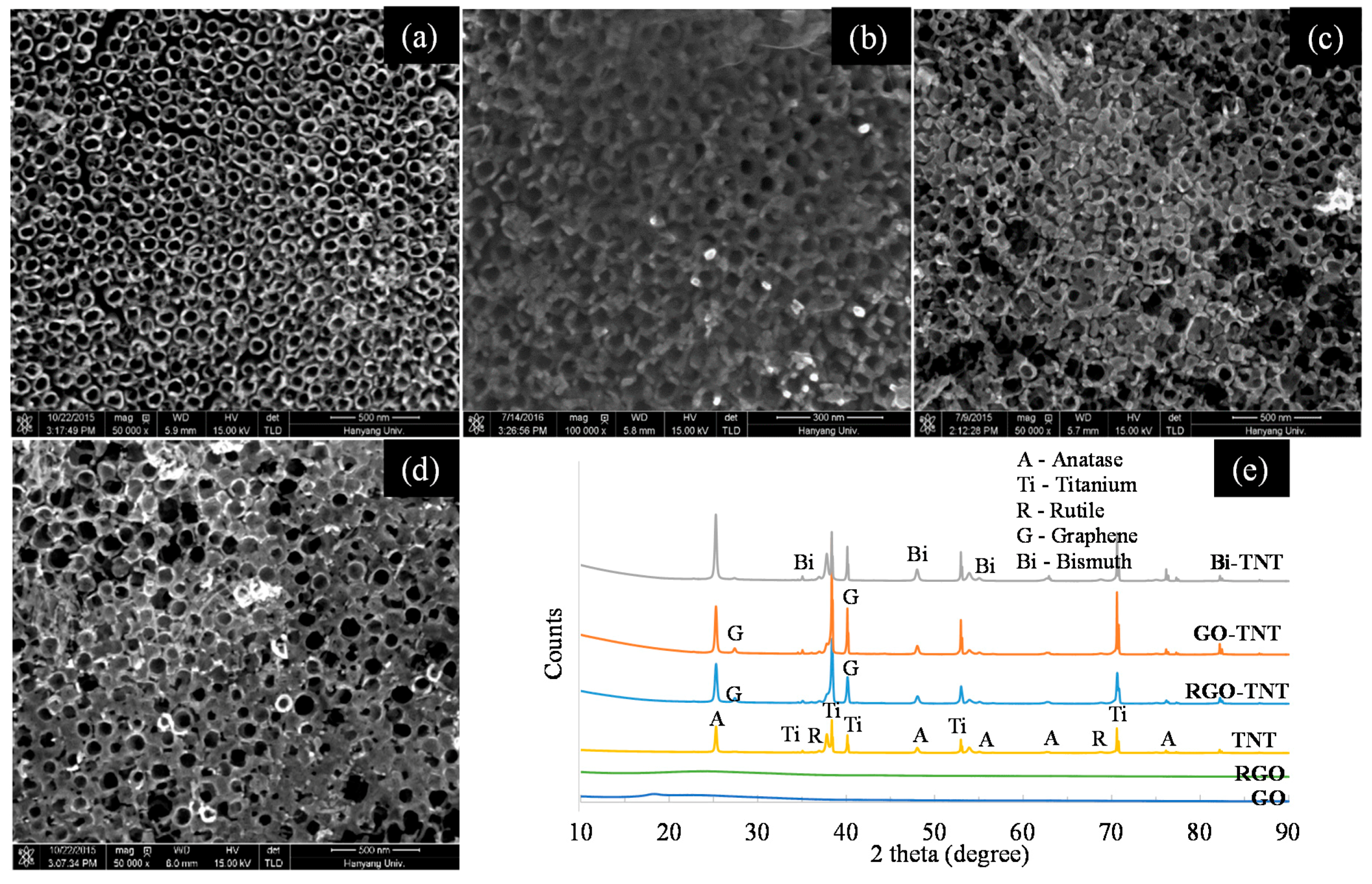
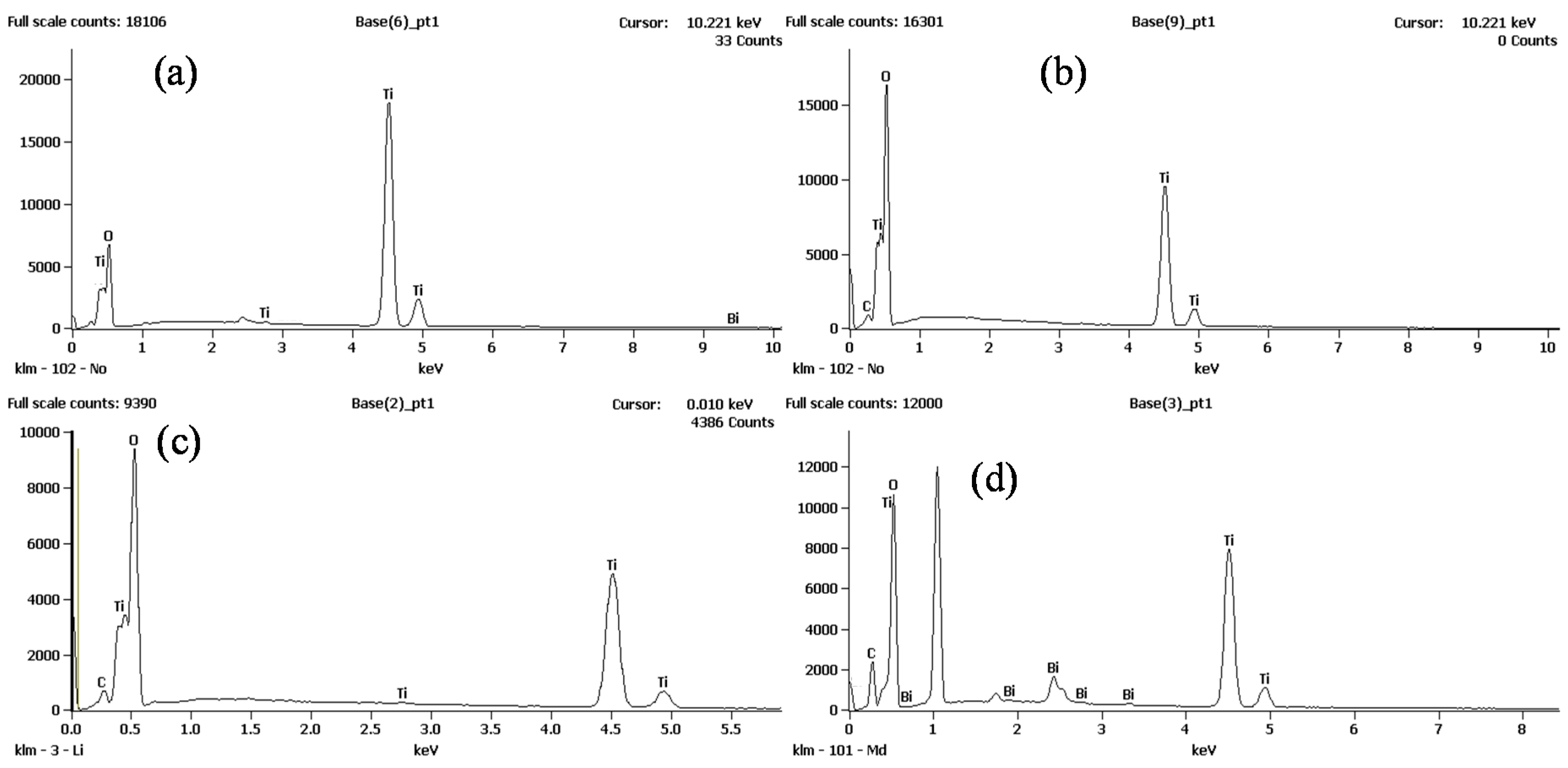
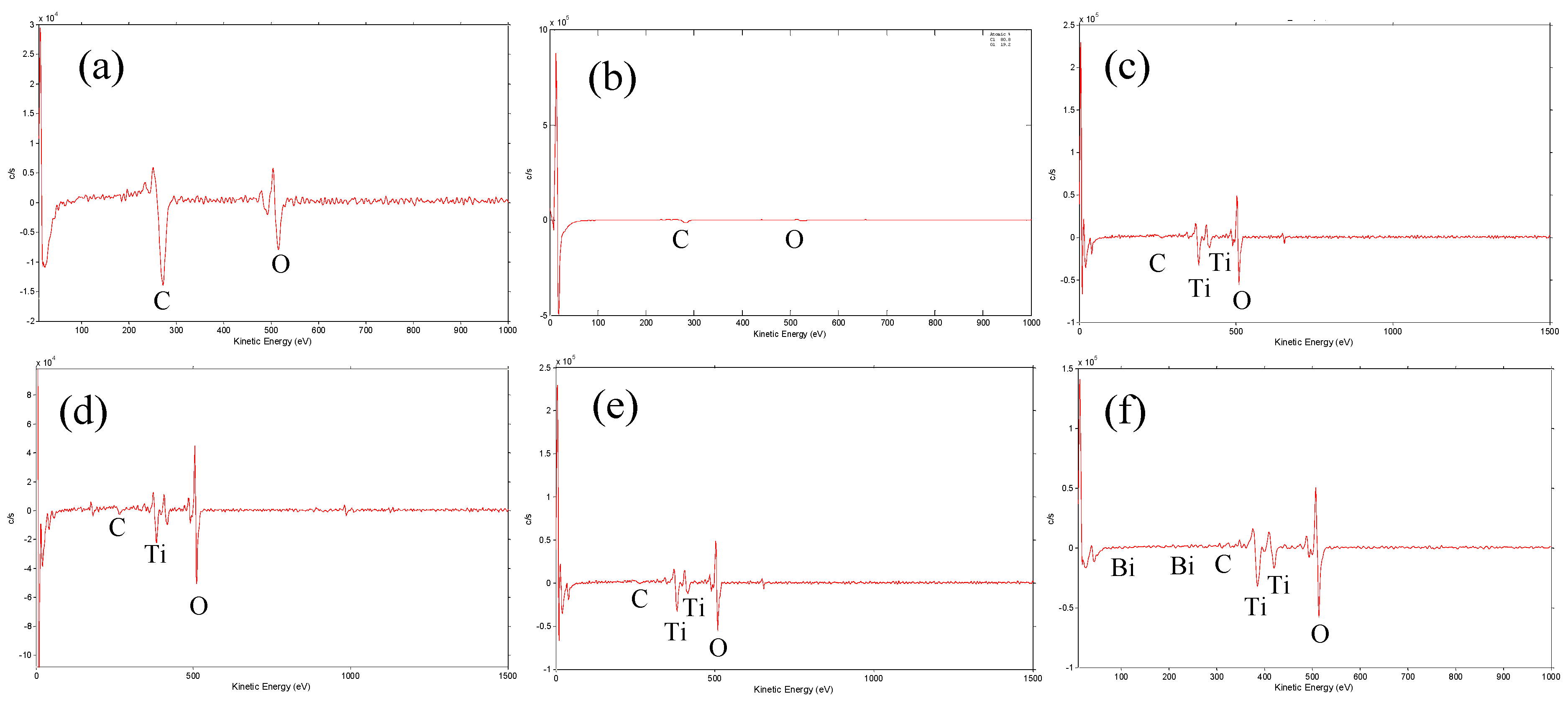
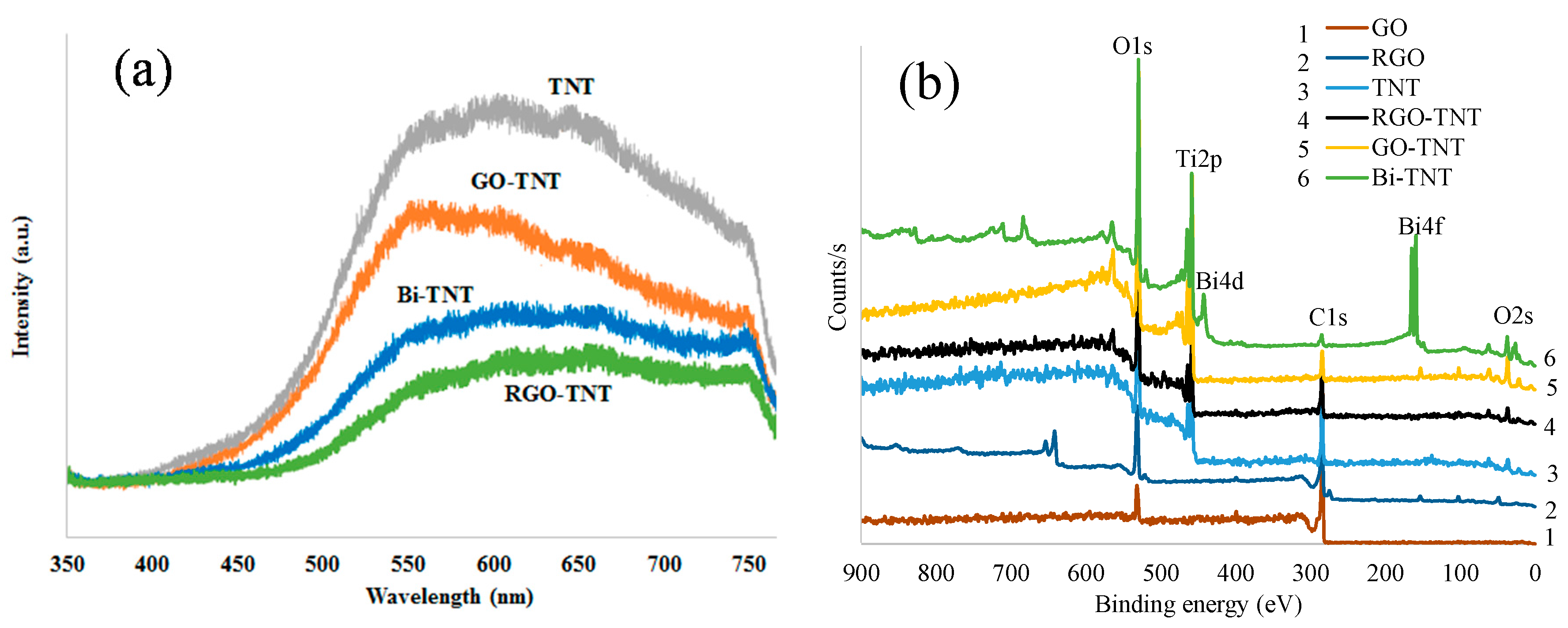

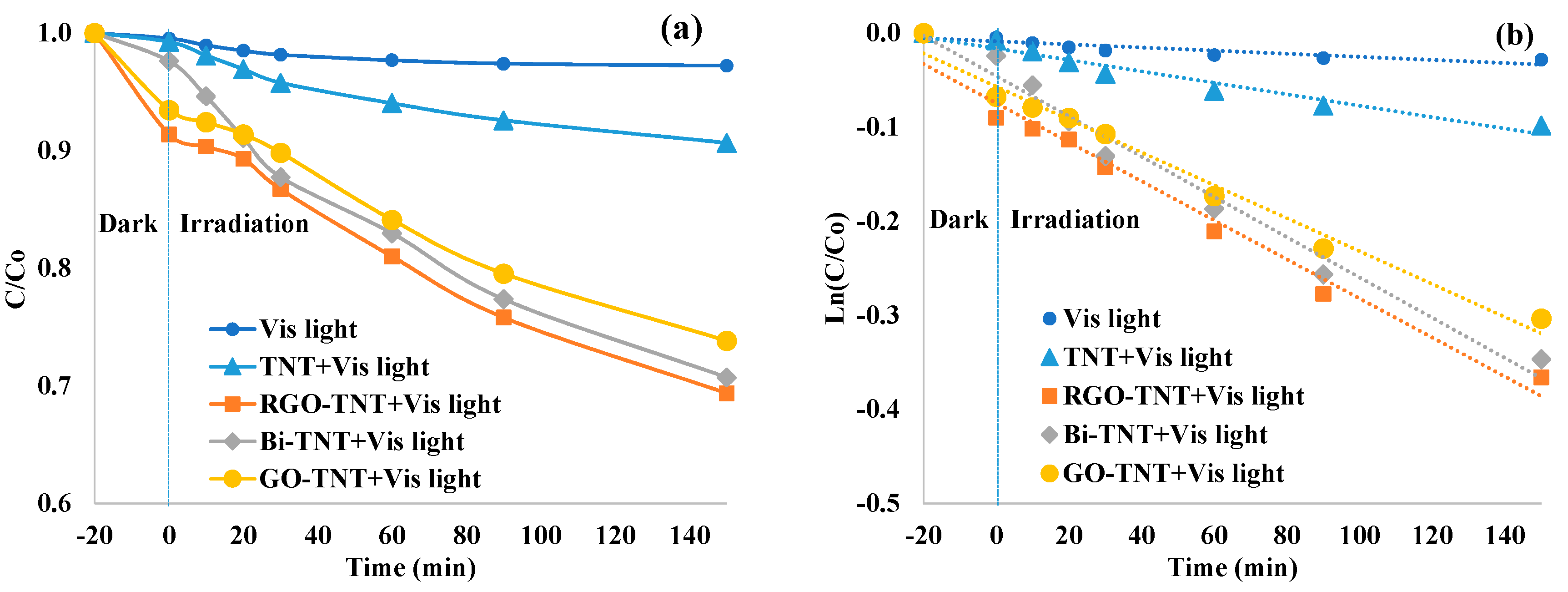
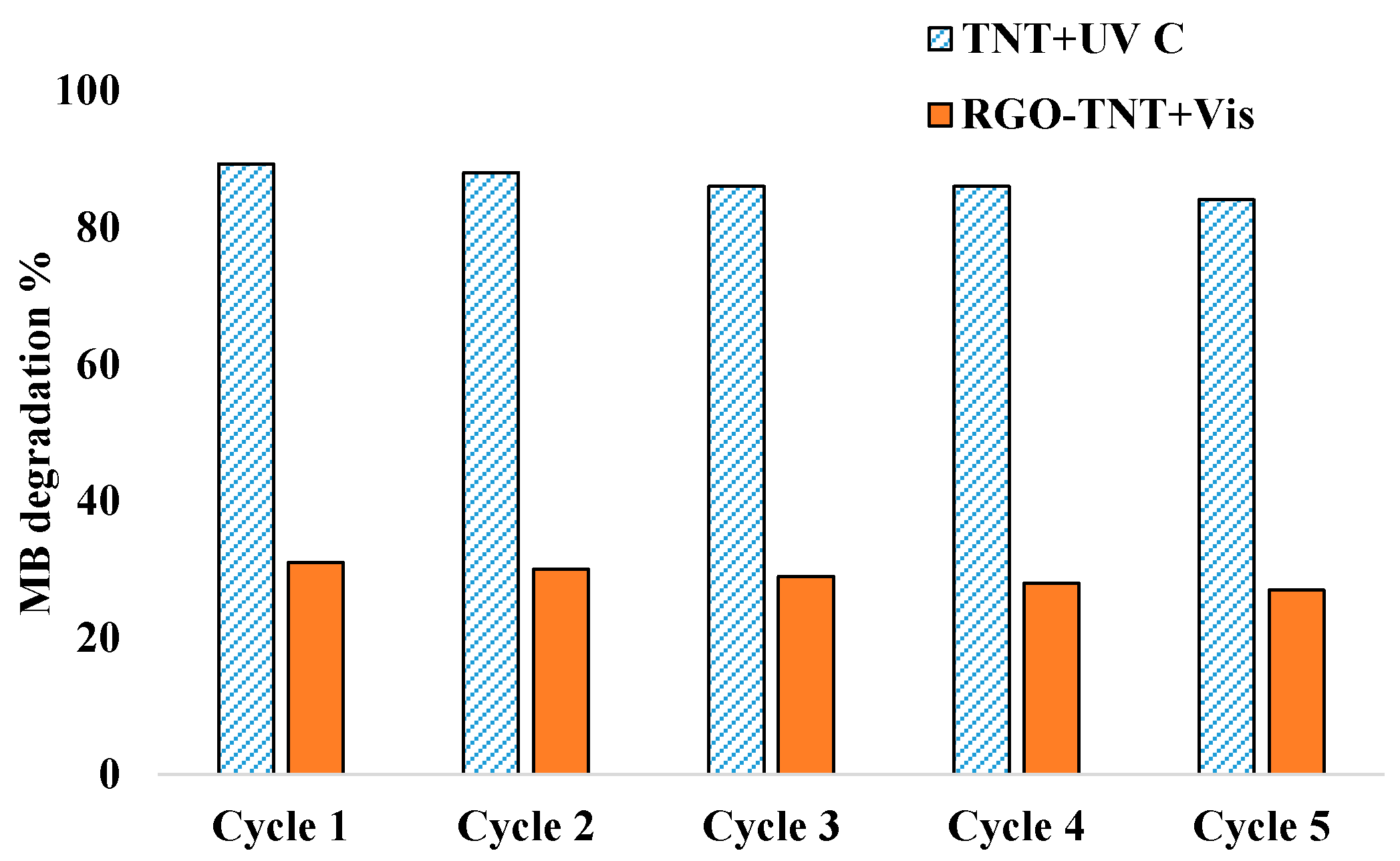

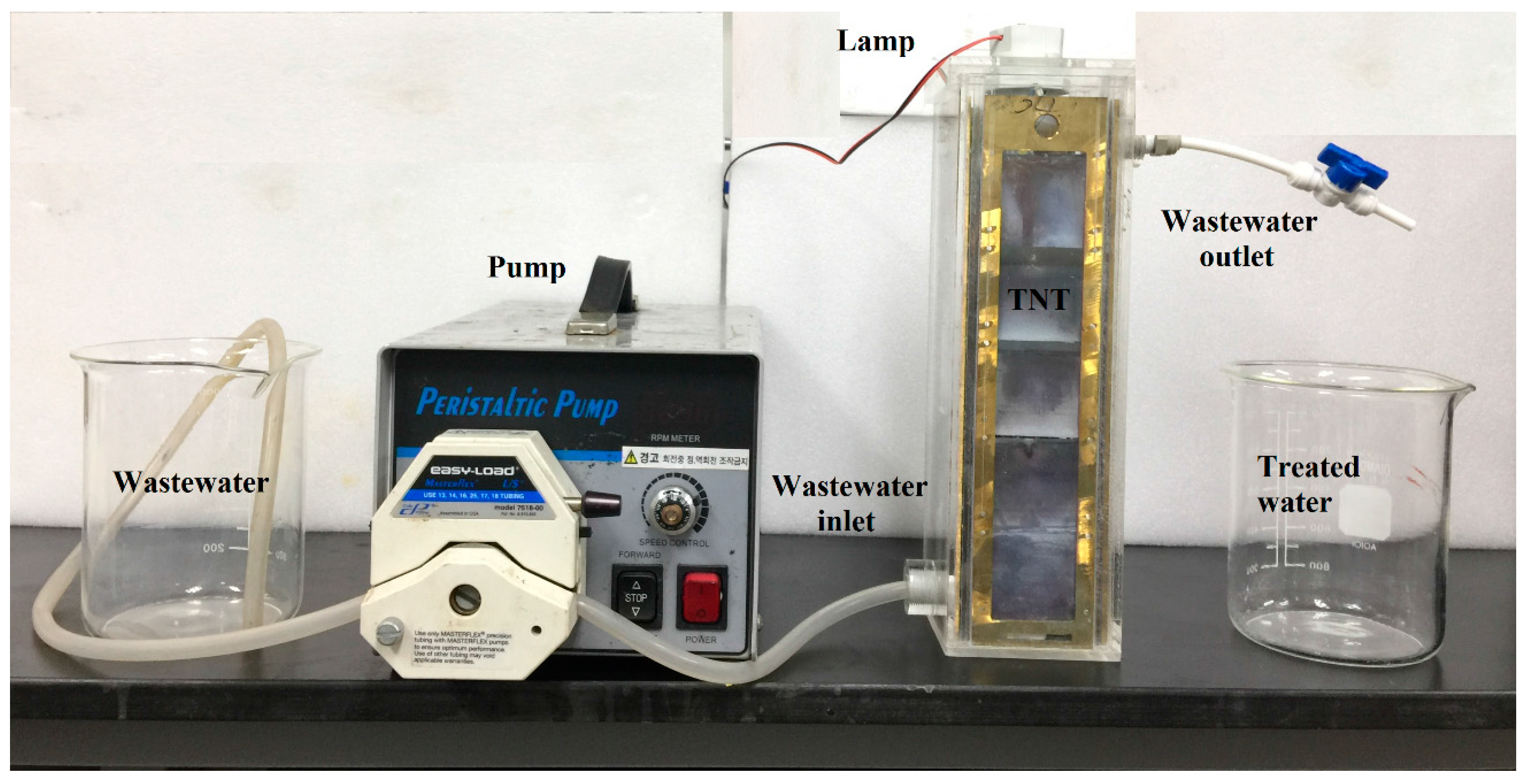
| Element (Atomic %) | Ti | O | C | Bi |
|---|---|---|---|---|
| GO | 18.6 | 81.4 | ||
| RGO | 27.2 | 72.8 | ||
| TNT | 33.4 | 62.5 | 4.1 | |
| RGO-TNT | 26.0 | 62.9 | 11.1 | |
| Bi-TNT | 12.9 | 68.9 | 8.2 | 10.0 |
| GO-TNT | 32.2 | 62.0 | 5.8 |
| Continuous Process | Rate Constant k (h−1) | R2 |
|---|---|---|
| TNT | 0.014 | 0.759 |
| UV C | 0.050 | 0.861 |
| TNTs + UV C | 0.893 | 0.966 |
| Vis light | 0.011 | 0.809 |
| TNTs + Vis light | 0.039 | 0.953 |
| RGO-TNTs + Vis light | 0.146 | 0.977 |
| Bi-TNTs + Vis light | 0.139 | 0.981 |
| GO-TNTs + Vis light | 0.121 | 0.982 |
| Detail | Unit | TNTs + UV C | RGO-TNTs + Vis |
|---|---|---|---|
| Step 1: Degraded MB Molecules Calculation | |||
| MB solution | L | 2 | 2 |
| MB concentration | g L−1 | 0.005 | 0.005 |
| MB weight in solution | g | 0.01 | 0.01 |
| MB molecular weight | g mol−1 | 319.85 | 319.85 |
| No. of MB moles in a solution | mol | 3.13 × 10–5 | 3.13 × 10–5 |
| No. of MB molecules in a mole | molecules mol−1 | 6.02 × 1023 | 6.02 × 1023 |
| Total no. of MB molecules | molecules | 1.88 × 1019 | 1.88 × 1019 |
| MB degradation in reactor | % | 89 | 31 |
| No. of degraded MB molecules | molecules | 1.68 × 1019 | 5.84 × 1018 |
| Step 2: Photon Energy Calculation | |||
| h is Planck constant | J s | 6.63 × 10–34 | 6.63 × 10–34 |
| c is speed of light | m s−1 | 3.00 × 108 | 3.00 × 108 |
| λ is wavelength | m | 2.54 × 10–7 | 5.00 × 10–7 |
| Photon energy (hc/λ) | J | 7.83 × 10–19 | 3.98 × 10–19 |
| Lamp power | J s−1 | 16 | 8 |
| Photons/second | photon s−1 | 2.04 × 1019 | 2.01 × 1019 |
| Irradiation time | s | 9000 | 9000 |
| Total no. of photons | photon | 1.84 × 1023 | 1.81 × 1023 |
| Quantum efficiency | MB molecule photon−1 | 9.11 × 10–5 | 3.22 × 10–5 |
| Detail | Value |
|---|---|
| Reactor length | 9 cm |
| Reactor height | 30 cm |
| Reactor width | 9 cm |
| Reactor wall thickness | 0.5 cm |
| Reactor effective volume | 1500 mL |
| Reactor material | Acrylic |
| Pipe diameter | 0.5 cm |
| Lamp diameter | 2 cm |
| Lamp length | 18 cm |
© 2018 by the authors. Licensee MDPI, Basel, Switzerland. This article is an open access article distributed under the terms and conditions of the Creative Commons Attribution (CC BY) license (http://creativecommons.org/licenses/by/4.0/).
Share and Cite
Ali, I.; Kim, J.-O. Continuous-Flow Photocatalytic Degradation of Organics Using Modified TiO2 Nanocomposites. Catalysts 2018, 8, 43. https://doi.org/10.3390/catal8020043
Ali I, Kim J-O. Continuous-Flow Photocatalytic Degradation of Organics Using Modified TiO2 Nanocomposites. Catalysts. 2018; 8(2):43. https://doi.org/10.3390/catal8020043
Chicago/Turabian StyleAli, Imran, and Jong-Oh Kim. 2018. "Continuous-Flow Photocatalytic Degradation of Organics Using Modified TiO2 Nanocomposites" Catalysts 8, no. 2: 43. https://doi.org/10.3390/catal8020043





